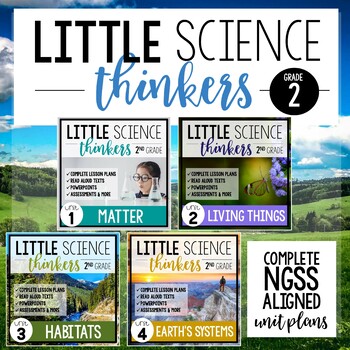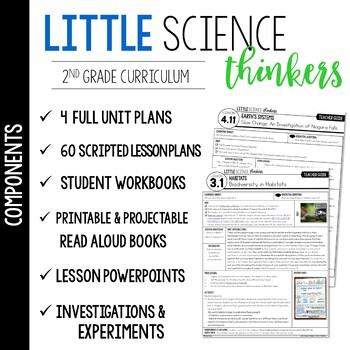Little 2nd Grade SCIENCE Thinkers - Curriculum Bundle
- Zip
What educators are saying
Products in this Bundle (4)
Description
Little SCIENCE Thinkers is a complete curriculum specifically for 2nd Grade. It's everything you need to introduce, teach, practice, and assess your students. It is cross-referenced and aligned with the Next Generation Science Standards (NGSS) and also addresses many of the main topics found in US state Science Standards for 2nd grade. Click here for the TEKS alignment.
This curriculum currently contains 4 unit plans, with 60 lessons. Most lessons take 1 class period to complete, however there are typically 1-2 lessons in each unit that will take multiple class periods.
Lessons are approximately 35-45 minutes in length.
The units and lessons included are:
Unit 1: MATTER
Lesson 1: BEING A SCIENTIST
Lesson 2: SCIENCE TOOLS AND SAFETY
Lesson 3: THE SCIENTIFIC METHOD
Lesson 4: STATES OF MATTER
Lesson 5: PROPERTIES OF MATTER
Lesson 6: DESCRIBING MATTER
Lesson 7: CLASSIFYING MATTER
Lesson 8: STRUCTURES AND MATERIALS
Lesson 9: ASSEMBLING AND DISASSEMBLING STRUCTURES
Lesson 10: CHANGING STATES OF MATTER
Lesson 11: REVERSIBLE AND IRREVERSIBLE CHANGES
Lesson 12: SCIENCE STATIONS
Lesson 13: SCIENCE STATIONS
Lesson 14: REVIEW
Lesson 15: ASSESSMENT
UNIT 2: LIVING THINGS
Lesson 1: LIVING THINGS ALL AROUND
Lesson 2: WHAT PLANTS NEED
Lesson 3: PLANT NEEDS EXPERIMENT
Lesson 4: INTERDEPENDENCE: SEED DISPERSAL AND POLLINATION
Lesson 5: ANIMAL NEEDS AND SURVIVAL
Lesson 6: MIGRATION AND THE ENVIRONMENT
Lesson 7: HIBERNATION, DORMANCY, AND THE ENVIRONMENT
Lesson 8: INTERDEPENDENCE: FOOD CHAINS
Lesson 9: PLANT LIFE CYCLES
Lesson 10: ANIMAL LIFE CYCLES
Lesson 11: OFFSPRING AND INHERITED TRAITS
Lesson 12: EXTINCTION AND FOSSILS
Lesson 13: SCIENCE STATIONS
Lesson 14: REVIEW
Lesson 15: ASSESSMENT
UNIT 3: HABITATS
Lesson 1: BIODIVERSITY IN HABITATS
Lesson 2: DESERT HABITATS
Lesson 3: TEMPERATE FOREST HABITATS
Lesson 4: GRASSLAND HABITATS
Lesson 5: MARINE HABITATS
Lesson 6: FRESHWATER HABITATS
Lesson 7: POLAR HABITATS
Lesson 8: TUNDRA HABITATS
Lesson 9: TROPICAL RAINFOREST HABITATS
Lesson 10: TROPICAL RAINFOREST CRAFTIVITY
Lesson 11: MICROHABITAT INVESTIGATION
Lesson 12: SCIENCE STATIONS (2 DAYS)
Lesson 13: HABITAT RESEARCH PROJECT
Lesson 14: REVIEW
Lesson 15: ASSESSMENT
UNIT 4: EARTH’S SYSTEMS
Lesson 1: THE SYSTEMS OF EARTH
Lesson 2: EARTH’S LANDFORMS
Lesson 3: EARTH’S WATER AND THE WATER CYCLE
Lesson 4: MAPPING LANDFORMS AND BODIES OF WATER
Lesson 5: MAKING A LANDFORM/WATER 3D MODEL
Lesson 6: HOW WATER CHANGES EARTH’S SURFACE
Lesson 7: WIND
Lesson 8: HOW WIND CHANGES EARTH’S SURFACE
Lesson 9: INVESTIGATION: DESIGNING A SOLUTION TO PREVENT WIND EROSION
Lesson 10: NATURAL EVENTS THAT CHANGE EARTH’S SURFACE
Lesson 11: SLOW CHANGE - AN INVESTIGATION OF NIAGARA FALLS
Lesson 12: FAST CHANGE - AN INVESTIGATION OF THE HOME REEF VOLCANO ERUPTION
Lesson 13: SCIENCE STATIONS
Lesson 14: REVIEW
Lesson 15: ASSESSMENT
-----------------WHAT’S INCLUDED IN EACH UNIT?--------------------
-60 Step-by-step, SCRIPTED Lesson Plans (15 Lessons per unit, 35-45 minutes each)
-Printable/projectable Books for Read-Alouds (7-10 nonfiction books per unit)
-60 PowerPoints (one for every lesson)
-Essential Question and Learning Target posters
-Easy to prep Science Investigations and Experiments
-Science Stations (5-6 Stations per unit)
-Anchor Charts
-Whole group and Independent Activities
-Student Workbook that follows each lesson
-Quick Check assessment for every lesson
-Primary-appropriate Assessment and Rubric for scoring
-Parent Letter
-All books, learning targets, most activities, and workbook pages are included in the lesson PowerPoints
-------DIGITAL LEARNING?-------
Each unit in this curriculum contains a PowerPoint that guides each lesson and contains the learning targets, read aloud books, and student workbook pages. You can upload each lesson PowerPoint to your Google Drive, open it in Google Slides, and save as a Google Slide document. (Please note, slides will not contain movable pieces.)
I also have a tutorial for using resources with the Seesaw app. You can find that HERE.
----------------------BUYING FOR A TEAM?--------------------------
LICENSING TERMS: This purchase includes a license for one teacher only for personal use in their classroom. Licenses are non-transferable, meaning they can not be passed from one teacher to another. No part of this resource is to be shared with colleagues or used by an entire grade level, school, or district without purchasing the proper number of licenses. If you are a coach, principal, or district interested in transferable licenses to accommodate yearly staff changes, please contact me for a quote at karen@mrsjonessclass.com .
**************************************************************************
Little Science Thinkers curriculum is an original teaching curriculum created and copyrighted by Karen Jones.
Files





